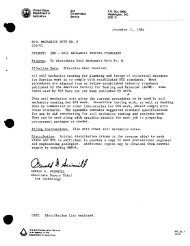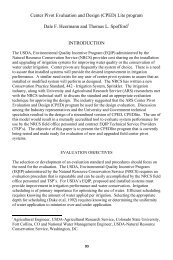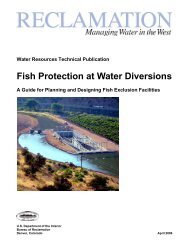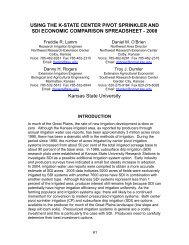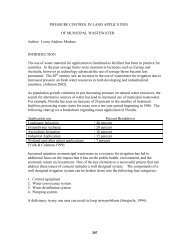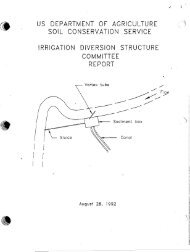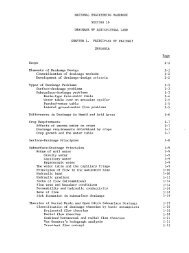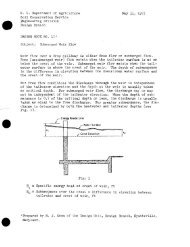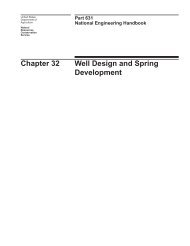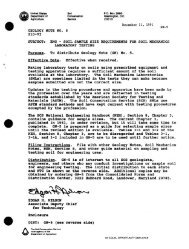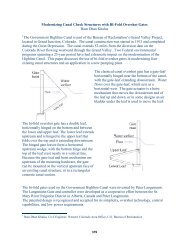Sprinklers, Crop Water Use, and Irrigation TIme, Box Elder County
Sprinklers, Crop Water Use, and Irrigation TIme, Box Elder County
Sprinklers, Crop Water Use, and Irrigation TIme, Box Elder County
Create successful ePaper yourself
Turn your PDF publications into a flip-book with our unique Google optimized e-Paper software.
APPENDIXAvailable <strong>Water</strong>-holding Capacity of Soils Typical <strong>Crop</strong> Rooting DepthsInches of availablewater per foot Permeability rate 1 Typical active rootSoil Texture of moist soil Inches/Hour <strong>Crop</strong> Zone depth, feetS<strong>and</strong>s <strong>and</strong> fine s<strong>and</strong>s 0.5 - 0.75 1.0 - 10 Alfalfa 5Very fine s<strong>and</strong>s, loamy s<strong>and</strong> .8 - 1.0 1.0 - 3 Corn 4 - 5S<strong>and</strong>y Loam 1.2 - 1.5 0.5 - 3 Small Grains 3 - 4Loam 1.9 - 2.0 0.3 - 0.8 Dry Beans 3Silt loam, silt 2.0 0.2 - 0.4 Pasture 1 ½ - 2 ½Silty clay loam 1.9 - 2.0 0.01 - 0.2 Potatoes 1 ½ - 2 ½S<strong>and</strong>y clay loam, Clay loam 1.7 - 2.0 0.1 - 0.6 Turf 1 - 2Vegetables 1 ½ - 3Note: Allowable depletion to avoid crop water stress is usually about 50% of available waterholding capacity for most field crops.1 Normal ranges. Intake rates vary greatly with soil structure <strong>and</strong> structural stability.The web site address for “Consumptive <strong>Use</strong> of Irrigated <strong>Crop</strong>s in Utah,” UAES Research Report#145, <strong>and</strong> the data tables used in Table 3 herein is found by going to the Utah Division of <strong>Water</strong>Rights home page at: http://nrwrtl.nr.state.ut.us/BIBLIOGRAPHYThen select “Publications” <strong>and</strong> then select “Consumptive <strong>Use</strong> Tables”Hill, R.W. 1991. <strong>Irrigation</strong> Scheduling. Chapter 12 in Modeling Plant <strong>and</strong> Soil Systems, John Hanks <strong>and</strong>J.T. Ritchie (eds.), American Society of Agronomy, Inc., <strong>Crop</strong> Science Society of America, Inc.,Soil Science Society of America, Inc., Madison, WI. 491-509.Hill, R.W. 1994. Consumptive <strong>Use</strong> of Irrigated <strong>Crop</strong>s in Utah. Utah Agr. Exp. Stn. Res. Report No. 145,Utah State University, Logan, UT. Oct. 370 pp. Revised <strong>and</strong> reprinted Feb. 1998.Hill, R.W. <strong>and</strong> R.G. Allen. 1996. Simple <strong>Irrigation</strong> Scheduling Calendars. Journal <strong>Irrigation</strong> <strong>and</strong>Drainage Division. ASCE. 122:2, March/April.Hill, R.W. , R.J. Hanks, <strong>and</strong> J.L. Wright. 1984. <strong>Crop</strong> Yield Models Adapted to <strong>Irrigation</strong> SchedulingPrograms. Utah Agr. Exp. Stn. Res. Report 99.For additional reading/resource material see:Larsen, D.C. <strong>and</strong> T.S. Longley. “Nozzle Management <strong>and</strong> Leak Prevention for Sprinkler <strong>Irrigation</strong>.”Current Info. Series No. 569. University of Idaho Coop. Extension Service, Moscow, ID 83843.MSU Agronomy Notes Series numbers 44, 47, 49, 53, 102, <strong>and</strong> 122. J.W. Bauder. Soil <strong>and</strong> <strong>Water</strong>Specialist; Plant, Soils <strong>and</strong> Environmental Science Department, Montana State University,8



